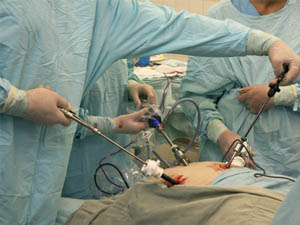Gastric Band Surgery
With over 500,000 Gastric Band surgeries performed worldwide, the Gastric Band is a viable and proven safe alternative offering excellent weight loss results. This surgery is minimally invasive and eliminates the need for gastrointestinal bypass of normal digestion and drastic stomach stapling. The adjustable Gastric Band, is a prosthetic silicone device that is inflatable and is placed around the top of the stomach by means of laparoscopic surgery. The Gastric Band limits the amount of food that the stomach will hold at any time by creating a smaller gastric pouch. The inflatable ring is what controls the flow of food from this smaller pouch to the rest of the digestive tract. The patient will feel comfortably full with a small amount of food. And because of the slow emptying, the patient will continue to feel full for several hours reducing the urge to eat between meals. The band is inflated/adjusted via a small access port placed just under the skin. Saline solution is introduced into the band via the port. A specialized needle is used to avoid damage to the port membrane. When fluid is introduced the band expands it places pressure around the outside of the stomach. The result is a decrease in the size of the passage in the stomach and restricts the movement of food. Over a period of time, restriction is increased until patients feel they have reached a "sweet spot" where optimal weight loss can be reached with the minimal fluid required. This is an individual experience and timing cannot be predicted. After adjustable Gastric Band surgery, you must get used to eating solid foods again. The first phase of recovery usually starts with two weeks of a liquid only diet followed by two weeks of semi solid or pureed foods followed by solid foods. It has been reported that until they eat their first full meal, many people say they can still eat relatively normal portions of food. This phenomenon is often referred to as bandster hell, because they become convinced that the surgery was not a success. The stomach needs to heal from surgery before the first fill.
The first adjustment isn't accomplished until approximately six weeks post surgery. Gastric bands should be adjusted approximately four to six times in the first year after surgery. These fills are done to make sure the band is not too tight or too loose and/or to encourage continued weight loss. Band adjustments are painless, and your surgeon can make them during a regular office visit. The weight loss that accompanies adjustable Gastric Band surgery is more gradual then with some other weight loss surgeries. You should lose about five to ten pounds per month and will most likely lose approximately two thirds of your excess weight within two years of having the surgery. After surgery you must be mindful about what you eat, how you eat and when you eat. Since the new stomach can hold only about a quarter cup to a full cup of food at a time, this involves eating smaller meals. Some people who have undergone gastric banding can eat a lot while others can't eat anything. It is important to "listen to the band" and not just try to eat the same amount each day. It is also important to chew carefully and stop eating when you feel full, or nausea and vomiting can occur. Don't eat and drink at the same time, because this may increase the chance of discomfort and vomiting. Individual experiences vary with food and eating after Gastric Band surgery. Some people have reported difficulty eating solid foods in the morning. It is important to pay attention to your body and how you feel when you eat different foods at different times. Talk to your surgeon or a registered dietitian about any problems you experience, as he or she will be able to offer tips on how to tweak your diet and eating habits.
Complications and Risks of Gastric Band surgery include: Bleeding; Infection; Band slippage; Band erosion; Band deflation; Stomach enlargement; Stomach outlet blockage; Gastroesophageal reflux or GER, and; Death. The risk of death due to gastric banding surgery is about one in 2,000. Compared with other types of weight loss surgery, adjustable Gastric Band surgery has these advantages: Can be done on an outpatient basis; Reversible; Less operating time; Adjustable; Less invasive; Does not interfere with vitamin absorption: Lower risk of dumping syndrome, which occurs when the undigested stomach contents are "dumped" into your small intestine too quickly. It is marked by abdominal cramps and nausea; Improves health problems related to excessive weight, including asthma, high blood pressure, sleep apnea, high cholesterol, and type 2 diabetes, and; Slow and steady weight loss. The cost of adjustable Gastric Band surgery usually ranges from about $17,000 to $30,000. Insurance companies may pay for all or part of the surgery and/or some or all of the fills. If you are considering weight loss surgery, the first step is to contact your insurance plan carrier to find out if the procedure is covered and what, if any, caveats may exist.

